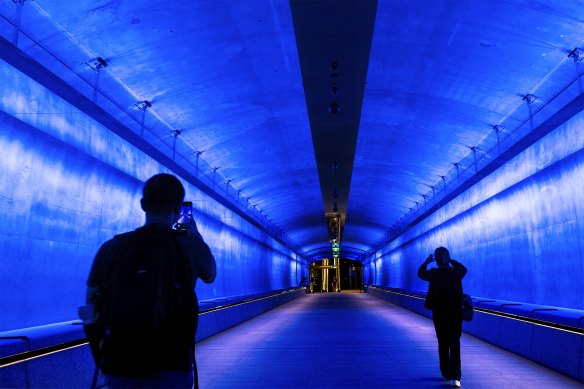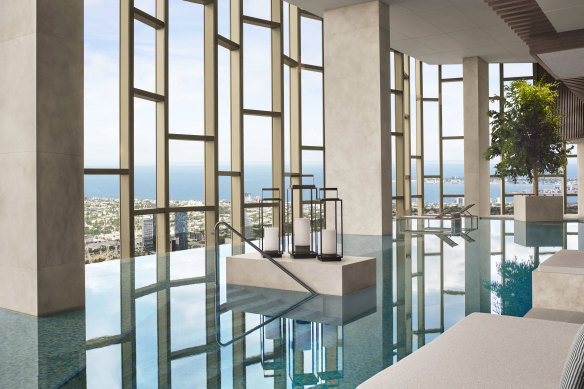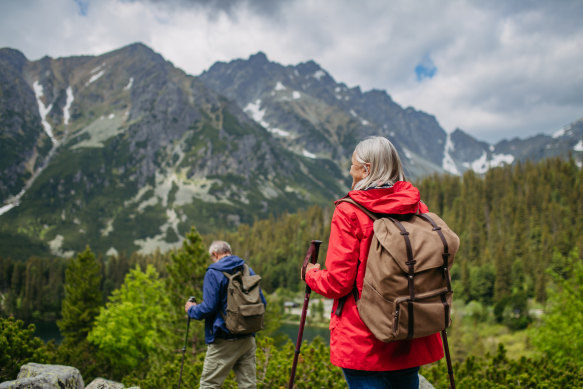Opinion
If Australians value our cities, why aren’t we holidaying in them?
Lee Tulloch
Travel columnistWhen Sydney’s sparkling new Metro City line opened last month, Sydneysiders took to the driverless trains in large numbers, not necessarily because they needed to get anywhere, but for the experience of visiting the five spectacular new stations on the route.
Australia’s biggest public transport project opened a new stretch of track from Chatswood in northern Sydney to Sydenham in the south-west. The new stations along the line, Crows Nest, Victoria Cross, Barangaroo, Gadigal and Waterloo, all feature dramatic architecture and striking art installations. Central Station has a beautiful concourse upgrade that recalls grand railway stations of the past.

Sydney’s new Metro has become a tourist attraction in itself.Credit: Steven Siewert
The Metro is an underground tourist attraction, rather in the way Moscow’s or Stockholm’s stations attract sightseers. It’s also a perfect excuse for Sydney people to take a staycation in town. “Let’s do the Metro, have a meal and stay overnight!”
During the pandemic, when we couldn’t go far, staycations were pretty much the only option if we wanted to travel, even if it only meant going a few kilometres. So many restrictions were in place, the CBD seemed as exotic as Cairo.
Desperate to go somewhere, people decided there was a silver lining to this – they could discover a city they’d always taken for granted and look at it with fresh eyes.

The heated infinity pool at the Ritz-Carlton Melbourne … same city, just a change of scenery.
Checking into a hotel near to home for a weekend or a couple of nights has long been popular with time-poor people who need to unplug from routine. Others come into the city not to relax but to take in as many activities as possible – restaurants, shows, museums, or special events such as Sydney’s Vivid or Melbourne’s Food and Wine Festival.
There’s something about staying in a hotel rather than your house that feels like a holiday. Maybe it’s as simple as having someone make your bed for you. Or maybe it’s a disconnection from the everyday drudgery at home, just suburbs away.
Now that people are travelling widely again, I’ve been wondering whether staycations are as popular with Australians. When I checked my mother into a Sydney hotel a few Fridays ago, there seemed to be plenty of guests like her arriving for the weekend, although most appeared to be international. Were Sydneysiders doing the same?
According to Booking.com, just 13 per cent of Aussie travellers took a staycation in 2023, with the same number planning to take one this year.
Staycation popularity is highest among Gen Z, with one in five (21 per cent) indicating they’d plan to take a staycation in 2024. Only 16 per cent of Millennials, 12 per cent of Gen X and just 5 per cent of Baby Boomers said they would.
I asked Todd Lacey, Booking.com’s regional manager for Oceania, why people were opting for fewer mini breaks closer to home.
“While the appetite for staycations has likely lessened now the world is open, and perhaps due to cost-of-living considerations, demand is typically tied to less frequent, more occasion-based travel.”
In other words, we’re forgoing the short breaks and putting those funds into saving for the big trips. A weekend away, even without airfares, can burn a rather large hole in the wallet, which might translate to three or four nights in a less expensive hotel in South America, or a few taverna meals in Greece.

Boomers are flocking overseas in large numbers right now.Credit: Getty Images
Perhaps this is why Boomers, gallivanting overseas in large numbers, might be less interested in spending their money at home. And why Gen Z, the most cash-strapped and environmentally conscious generation, might look at ways to explore the world closer to home without a large carbon footprint.
It all comes down to how we value our cities. When I lived in New York, I rarely went to concerts, theatre, restaurants, bars, galleries and museums. It was enough to know that I could if I wanted to.
It’s the same with Sydney, where I live now. It will always be there. Plenty of time to explore, I always think.
The number of Australians returning from international trips has now surged above pre-pandemic levels, according to new data from the Australian Bureau of Statistics (ABS); every month of 2024 (except for May) surpassed pre-COVID volumes.
But cities of almost 5 million people are constantly reinventing themselves. They’re growing, changing places that hold many secrets and surprises. It’s not just the architecture and streetscapes, but the human stories of small businesses that open and close in the laneways.
Grown up cities have great public transport systems that give them vitality. Sydney’s dazzling new Metro will no doubt bring more people into the centre. They’re coming for the 100 km/h train ride, to wonder at the architecture and contemplate the free art.
Getting them to stay will be the thing.
Sign up for the Traveller Deals newsletter
Get exclusive travel deals delivered straight to your inbox. Sign up now.